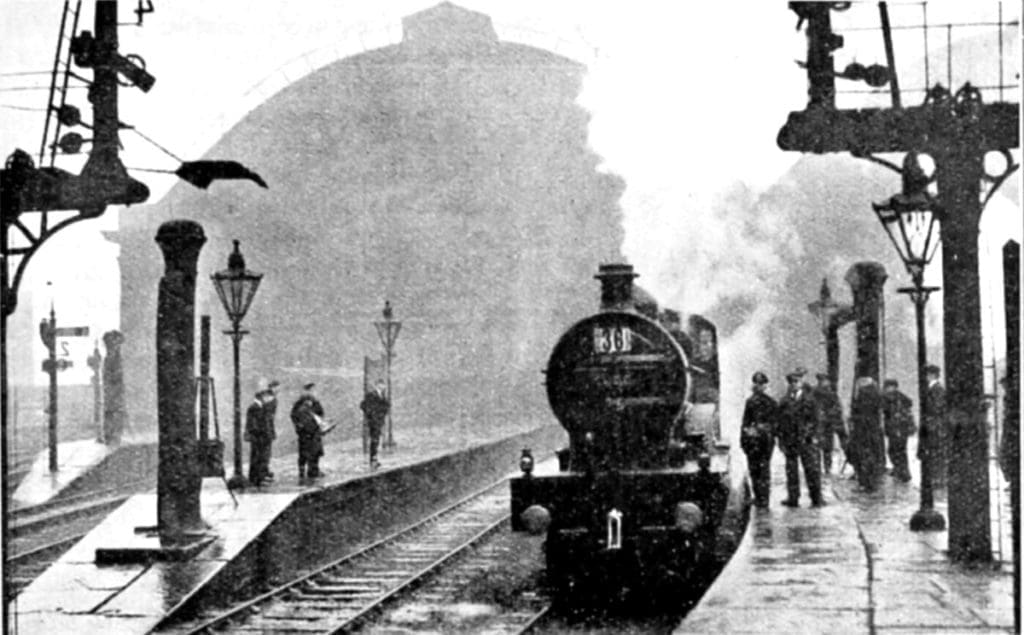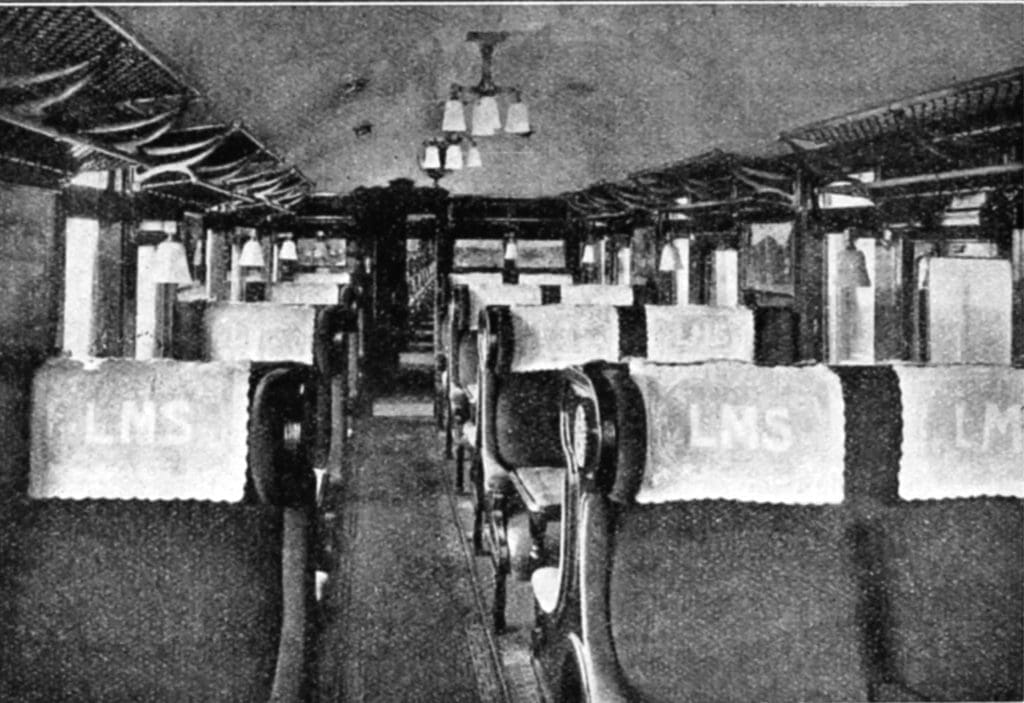Reprinted from the April 1925 issue of The Railway Magazine – the fastest post-war service between London and Bradford.

Although, not quite the fastest service ever given by the Midland route, in that before the war there was one up express from Bradford to St. Pancras in four hours, 13 minutes. New expresses inaugurated on March 2, running direct from St Pancras to Bradford (Exchange) via Thornhill, represent a development in traffic facilities of special importance. Associated there with the fact that the new trains, which are booked in 4 and quarter hours, an acceleration of about 20 minutes.
On the present-best times, call only at Leicester and Sheffield intermediately. Also, they are made up of rolling-stock of new design, all passenger coaches being of dining-car type, and fitted throughout with tables, while the central kitchen car is able to supply, if need be, every passenger in the train with lunch, tea or dinner, as the case may be, at one sitting.
As the new service is essentially designed, to meet the needs of the considerable business travel between Bradford and Sheffield and London, the up train is booked to leave Bradford (Exchange) at the convenient time of 9:10am and Sheffield at 10:15 am reaching St Pancras at 1:25pm, this allowing for a full afternoon’s business in London before making the return journey from St Pancras at 4:55pm.
The down service is correspondingly convenient, in that Sheffield is reached at 8:05pm and Bradford at 9:10pm, while the service, will, no doubt, be equally appreciate by Leicester passengers, who will then be given a non-stop service in 107 minutes, at a time particularly suitable for returning business men.
So far as the schedule in detail is concerned, it may be mentioned that the 99 miles between St Pancras and Leicester and Sheffield are allowed 78 minutes up and 79 minutes, down, while the complicated 39 and a half miles between Sheffield and Bradford are allowed 60 minutes, up and 61 down. Seeing that from Trent Junction northwards the route, like most of those in the busy area concerned is complicated by the frequent need for reducing speed at junctions and for curves and gradients in many places are by no means easy, these times are probably as good as can be given.

It may be mentioned that, on a trial run recently, one of the standard Midland compound 4-4-0 locomotives, No. 1036, on a slightly easier schedule, usually ran appreciably before time, notwithstanding one or two intermediate checks. This, On the down journey, 109 min. 10 sec. (allowed 111 min.) were taken from St Pancras to Leicester, including one bad signal check; the time from Leicester to Sheffield was 77 minutes, 20 seconds. (Scheduled in 79 mins) and from Sheffield to Brad- ford, including delays, 66 min. 25 sec. On the up journey the same engine ran from Bradford to Sheffield in 57 min. 40 sec., from Sheffield to Leicester in 78 min. 20 sec., and from Leicester to St. Pancras in the exact 108 min. From the locomotive point of view the new service is an easily practicable one, and no doubt time can be kept with a substantial increase in loading.
Principal interest attaches, however, to the rolling stock employed. The new Bradford train includes six passenger coaches, arranged three on each side of the kitchen car. In one direction there is a first-class car, together with an ordinary third and a brake-third, coach. At the other end all three vehicles are intended for conveying third-class passengers. All vehicles are of central gangway type; each is in two sections: smoking and non-smoking and every seat on the train has table equipment.
There are 234 seats for third-class and 36 for first-class, or a total of 270 passengers, while the kitchen has capacity for about 250 meals. Obviously, in the ordinary way, passengers who are taking lunch or dinner will be concentrated, as far as possible, in the vehicles immediately adjacent to the kitchen car staff will be prepared to serve meals in any part of the train, and gangway widths and vestibule dimensions are designed so as facilitate the movements of waiters, even should they require to travel the comparatively considerable distances involved in serving in the father cars.
Even if not required for meal purposes the tables will be no doubt be appreciated, very greatly by passengers, in that business men will be able to attend to correspondence, and while travelling or if there is no need for that, the table will be useful as a support for one’s book or paper.
Another point of interest is that some, if not all, of the third-class cars have practically the same seating and other dimensions as the first-class cars, so that no inconvenience arises when two passengers (particularly if substantially built) are seated on the same side of a table, as it does in some third- class dining cars, which may at times be somewhat uncomfortably crowded for this reason. A great point is moreover, that, notwithstanding the comfort of the seating accommodation and the high quality of the appointments and fittings throughout the train, no charge is incurred beyond the payment of ordinary fares.
Futher, the third-class cars are finished in polished mahogany and trimmed in York velvet, and the metal fitting finished Venetian bronze. All ceilings are enameled glossy white. Special attention has been given to the ventilation of the cars by means of adjustable louvre ventilators,
Electric fans, drop lights in convenient positions, and “torpedo” LINCOLN air extractors in the roof. The kitchen car is utilized for cooking and culinary purposes only. Every convenience is provided for the chef and train staff, to facilitate the serving of 250 meals at one sitting. The vehicles are electrically lighted from dynamos driven from the carriage axles, accumulators being provided to give light when the train is stationary. Lamps carried in electrifiers of tasteful design are arranged in the ceiling and over each table. For the purpose of minimizing noise, the floors are covered with felt under the linoleum. An efficient steam-heating system has been pro- vided, and is under the control of the passengers. At the ends of the coaches, in addition to conveniently arranged lavatories, supplied with both hot and cold water, space is provided for racks for passengers’ personal luggage, which is thus kept within sight but clear of the seating part of the coach.

In general construction the passenger Vehicles corresponds. Each coach is 57ft. over the body and 9 ft. 1 1/2in. wide as a maximum. Each bogie has a wheelbase of 9 ft., and the distance be- tween the bogie centers is 40ft. 6in. The third-class cars each have a seating capacity for 56 passengers, and in the case of first-class cars 36 can be accommodated. The weight of each vehicle is 27 tons.
The kitchen car, which weighs 29 tons, includes a central kitchen equipped with a large gas stove, hot plate of generous dimensions, and two hot-water boilers, one for washing and kitchen purposes and the other for tea-making, &c. On either side of the kitchen section are pantries, and in addition there is a seating compartment for the kitchen staff, and toilet facilities. There is also a plate-warming cabinet with a capacity for 500 plates, together with refrigerators, wine coolers, &c.
On the occasion of the trial journey mentioned above, the party was accompanied by Mr. J. H. Follows, C.B.E., Chief General Superintendent; Mr. R. W. Reid, C.B.E., Carriage and Wagon Superintendent; Mr. T. C. Jeffrey, Superintendent of Publicity and Advertising; Mr. C. F. Graseman, Publicity Liaison Officer, General Managers Department; Mr. J. Walker, and others.
Commencing On March 2, the 10 a.m. service from Euston to Glasgow, Edinburgh and the North was scheduled to run in two sections, the Glasgow portion leaving at 10 a.m. and the Edinburgh and North section at 10.8 a.m. At the same time entirely new sets of vehicles were pro- Vided. In the case of the Glasgow section, the make-up is in general similar to that of the new trains introduced for the London- Bradford service described above, modified slightly to meet the requirements of this particular traffic.
The make-up includes a central kitchen car, together with one central-corridor first-class carriage, one corridor first-class vehicle, two central-corridor third-class coaches, and a corridor-brake third, together with a brake van. There is thus a compromise between the arrangements adopted for the Bradford train, in that the Glasgow train is not entirely made up of semi-open vehicles of dining-car type. Ample luggage accommodation is pro- vided, while the capacity of the kitchen car is sufficient to enable every passenger in the train to be served simultaneously, if required. Normally, this is hardly likely to be the case, but, however ‘full the train may be, there is sufficient table accommodation to enable all passengers who may desire to take lunch or tea to be accommodated at one sitting. The needs of passengers joining the train by means of attached through coaches or other vehicles which may be included in the make-up during the journey can also be supplied. The standard make-up provides for 72 first and 138 third-class passengers.
In the case of the Edinburgh section, five vehicles provide basis for the train, including a vestibule third-class vehicle, a corridor break composite and a corridor-brake third. Seating accommodation is provided for 68 first and 114 third-class passengers. In running, the Aberdeen and Dundee vehicles are, of course, attached to the Edinburgh portion.
As in the case of the Bradford train, the generous provision of tables constitutes a special feature of the new sets, combined with the ability to serve meals at one sitting, instead of in relays, as was so often necessary. Other special features are that the fullest advantage has been taken of the maximum width allowed in order to make the compartments as commodious and comfortable as possible. The first- class vestibule cars are finished in polished walnut and trimmed in blue cloth, and all metal fittings are of oxidised silver.
The third-class vestibule cars are finished in polished mahogany and trimmed in York velvet, and the metal fittings finished Venetian bronze.
All ceilings are enameled glossy white. Special attention has been given to the ventilation of the cars by means of adjustable louvre ventilators, electric fans, droplights in convenient positions, and ‘torpedo’ air extractors in the roof. The vehicles are electrically lighted from dynamos driven from the carriage axles, accumulators being provided to give light when the train is stationary. Lamps carried in electroliers of tasteful design are arranged in the ceiling and over each table.
There is a lavatory accommodation with a plentiful supply of hot and cold water, in every coach. At the end of each vehicle ample room for storing passenger’s personal luggage, is provided. For the purpose of minimizing noise, the floors are covered with felt under the linoleum. An efficient steam-heating system has been provided, and is under the control of the passengers.
Although the Edinburgh portion on the down journey is now run behind the Glasgow section, the standard arrival time at Edinburgh (Princes Street) is maintained. The Glasgow and Edinburgh trains run together from Crewe on the up journey. The new trains have been constructed to the designs of M. R. W. Reid, C.B.E, Carriage and Wagon Superintendent, L.M.S.R, at the Derby Carriage Works.

Advert




